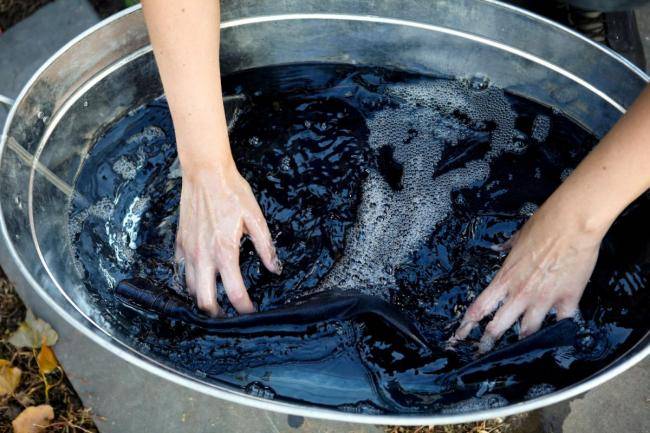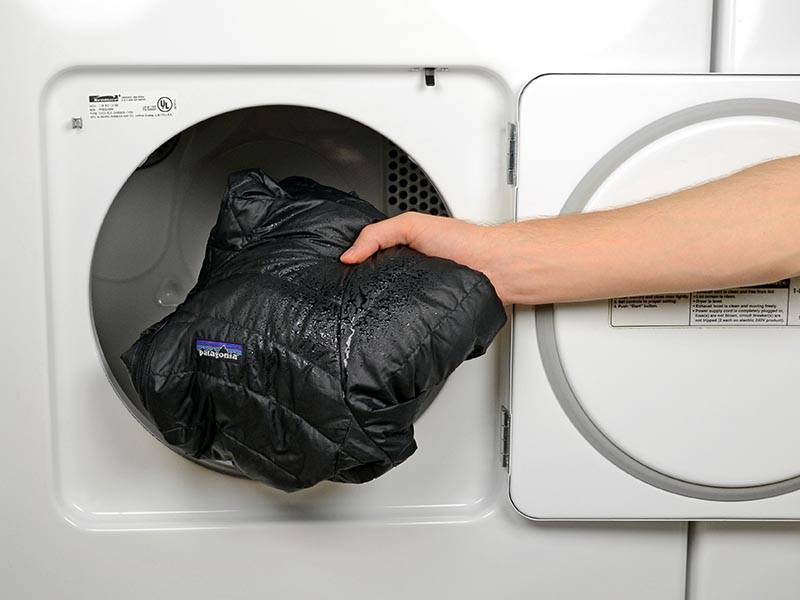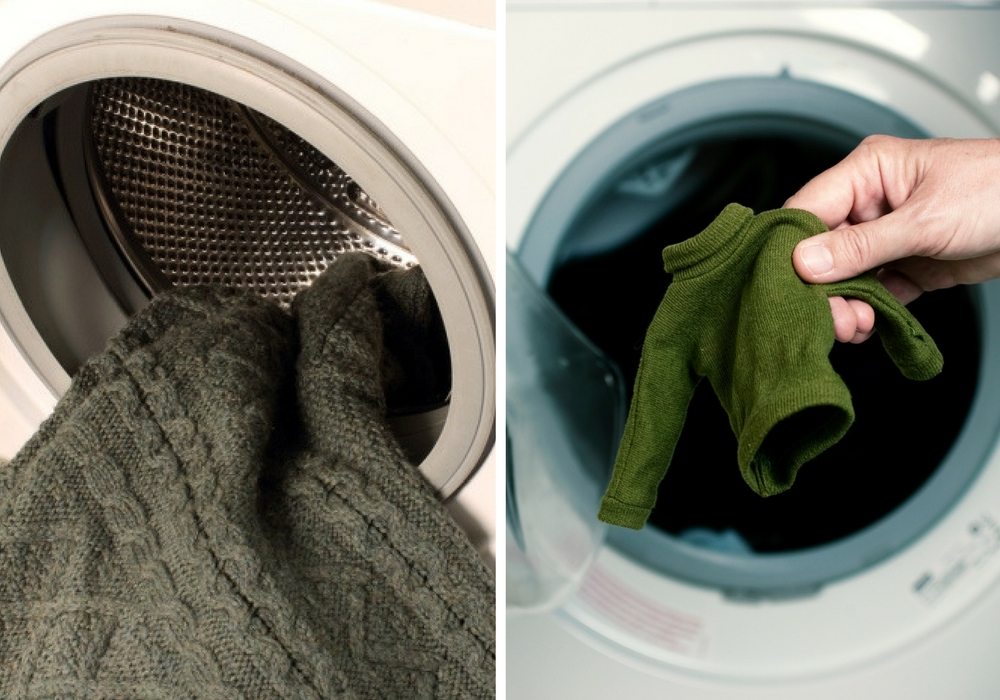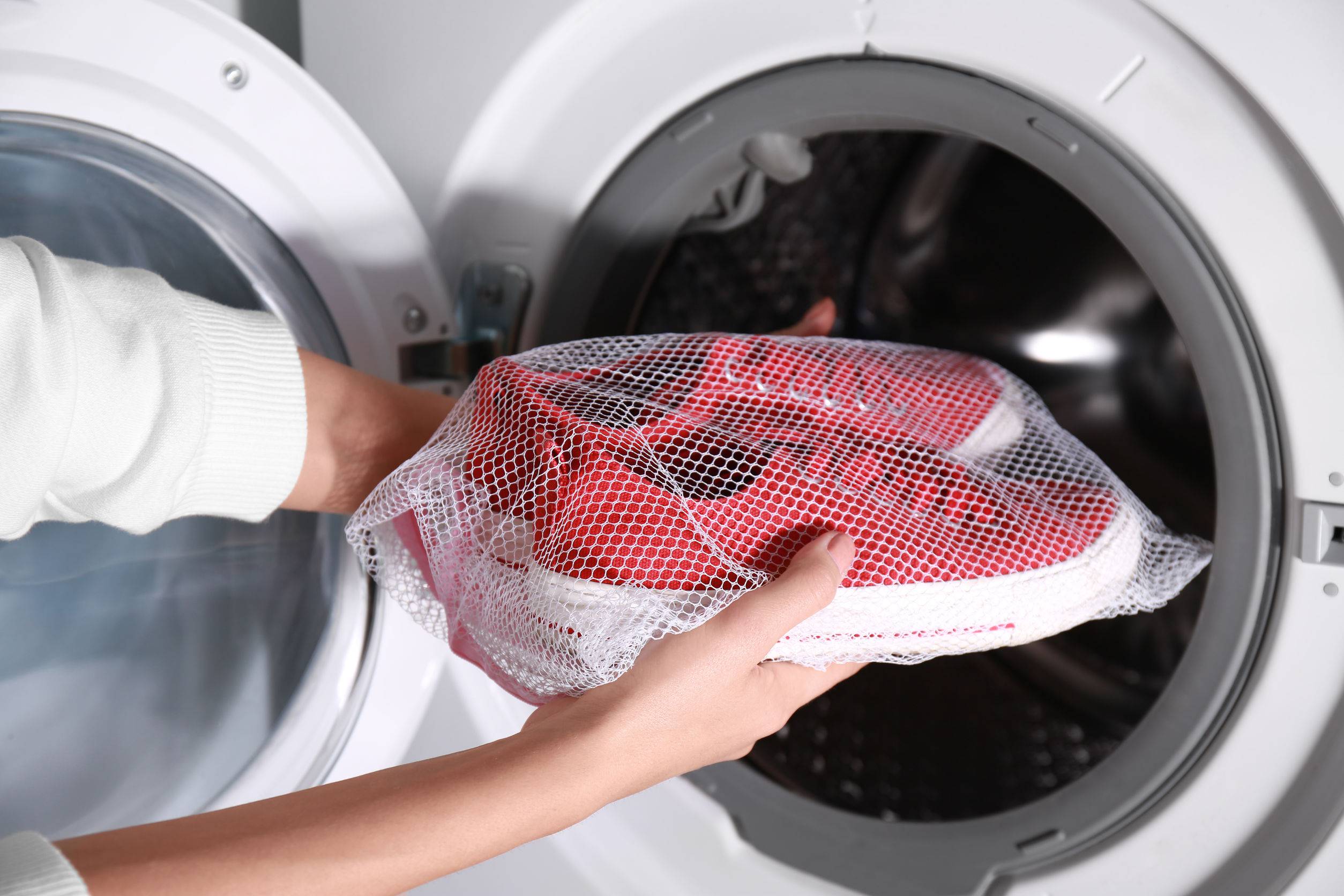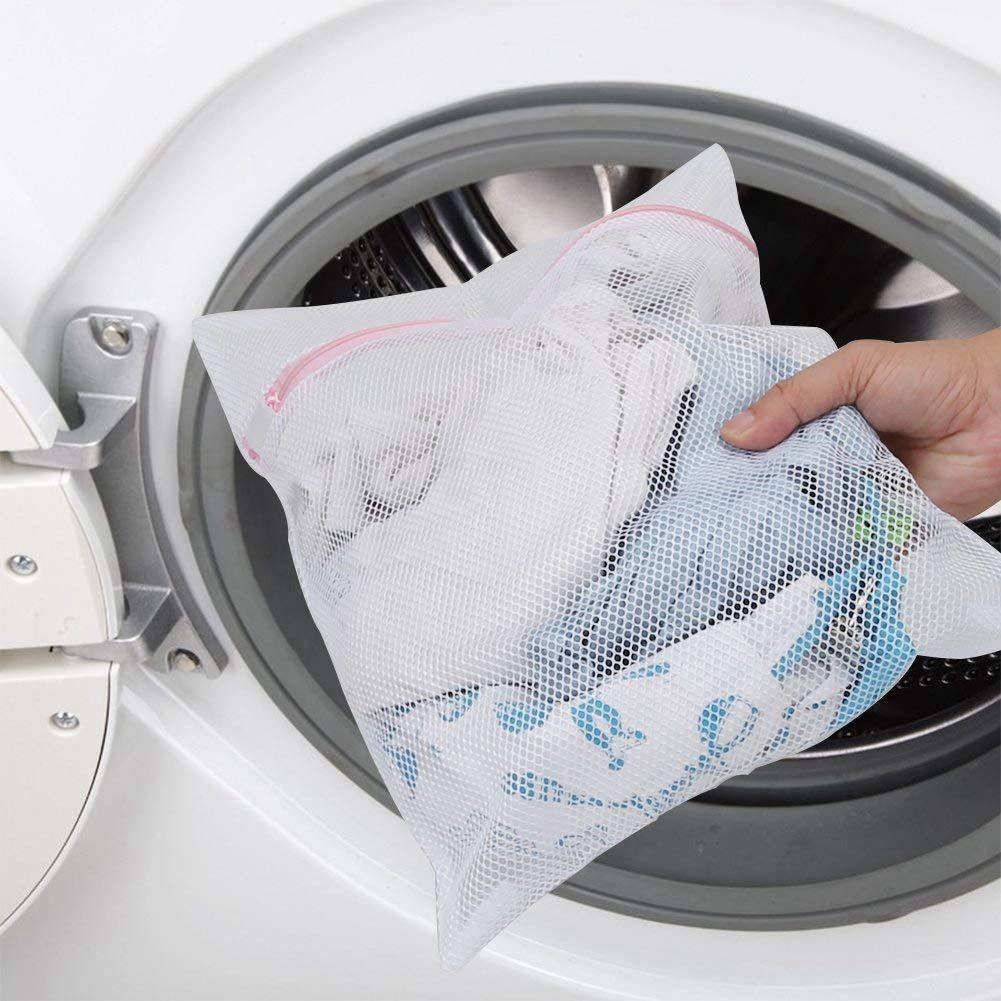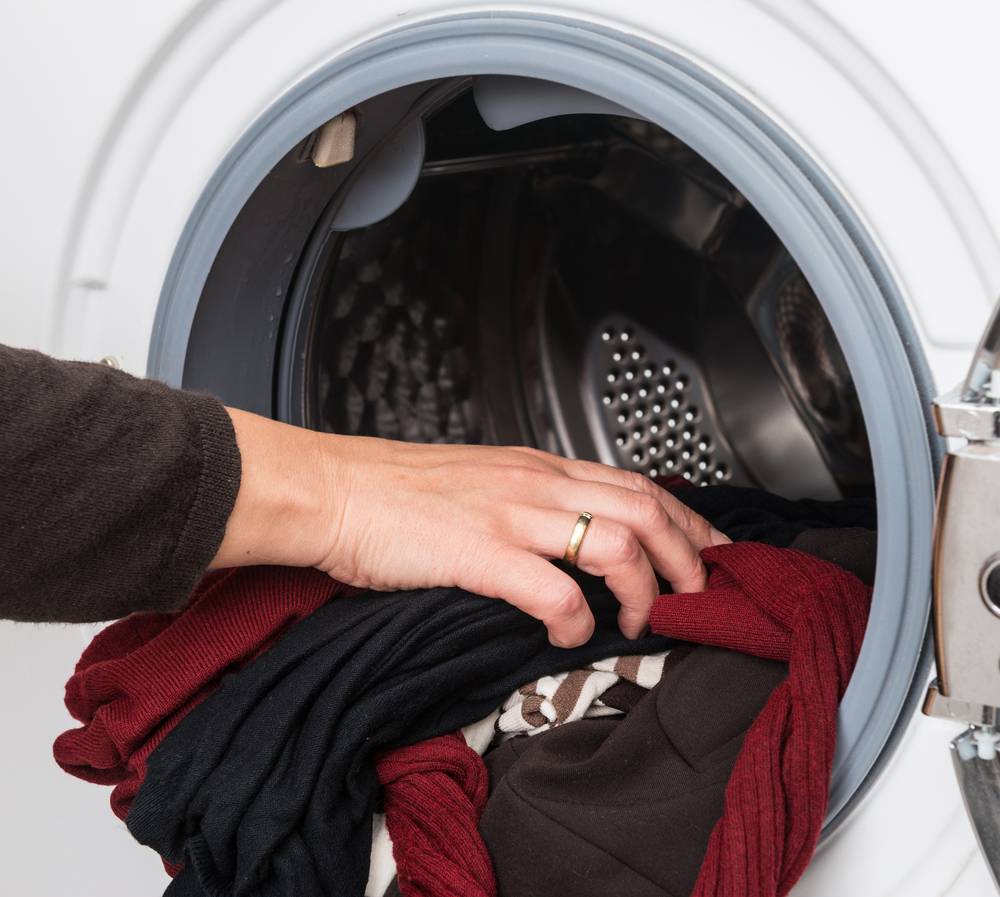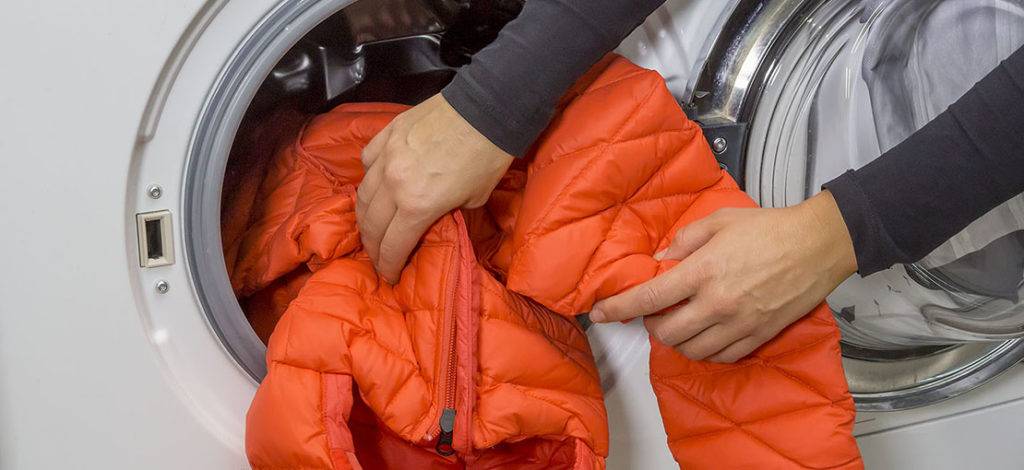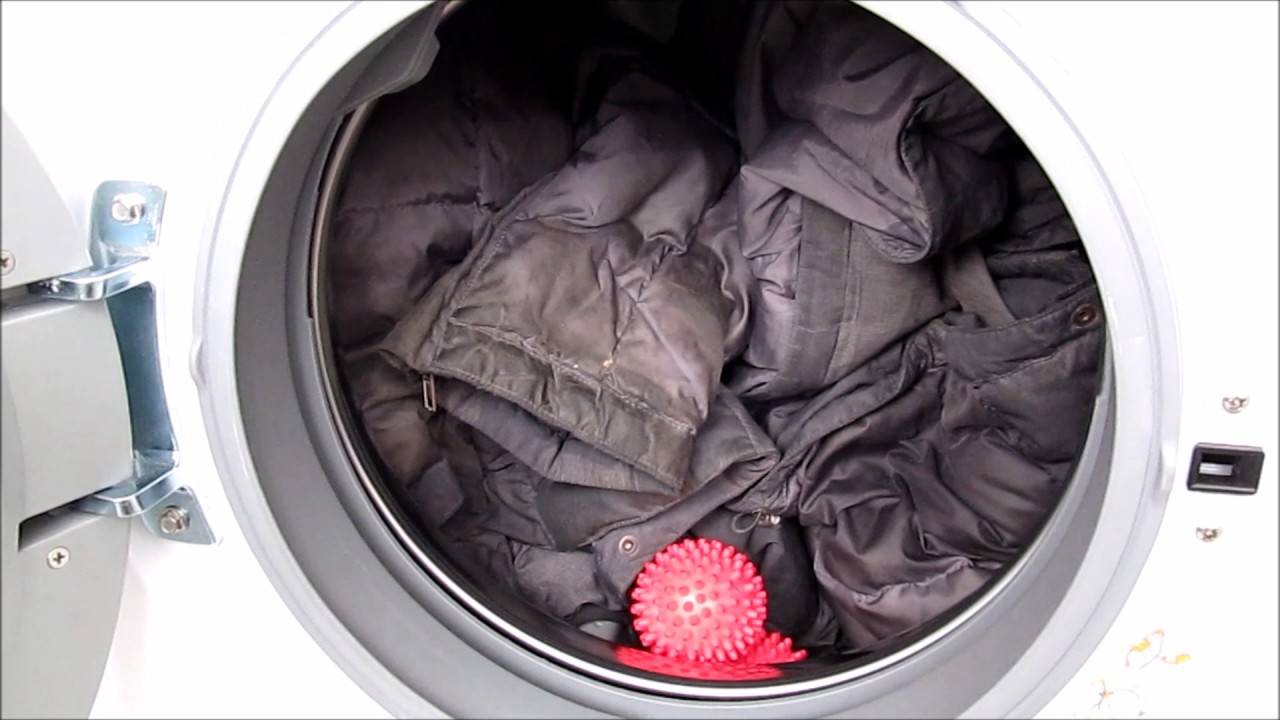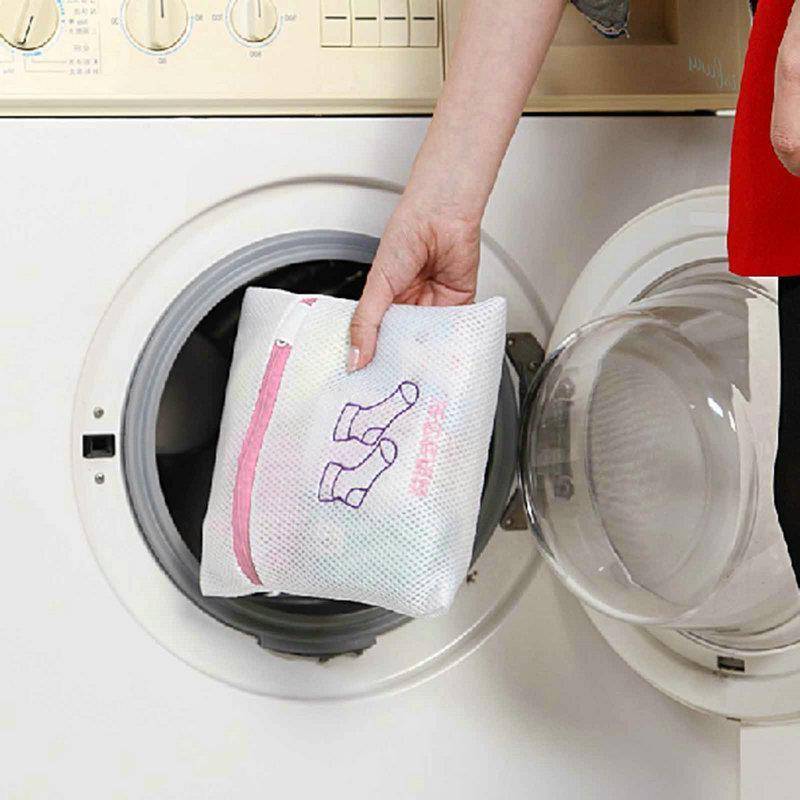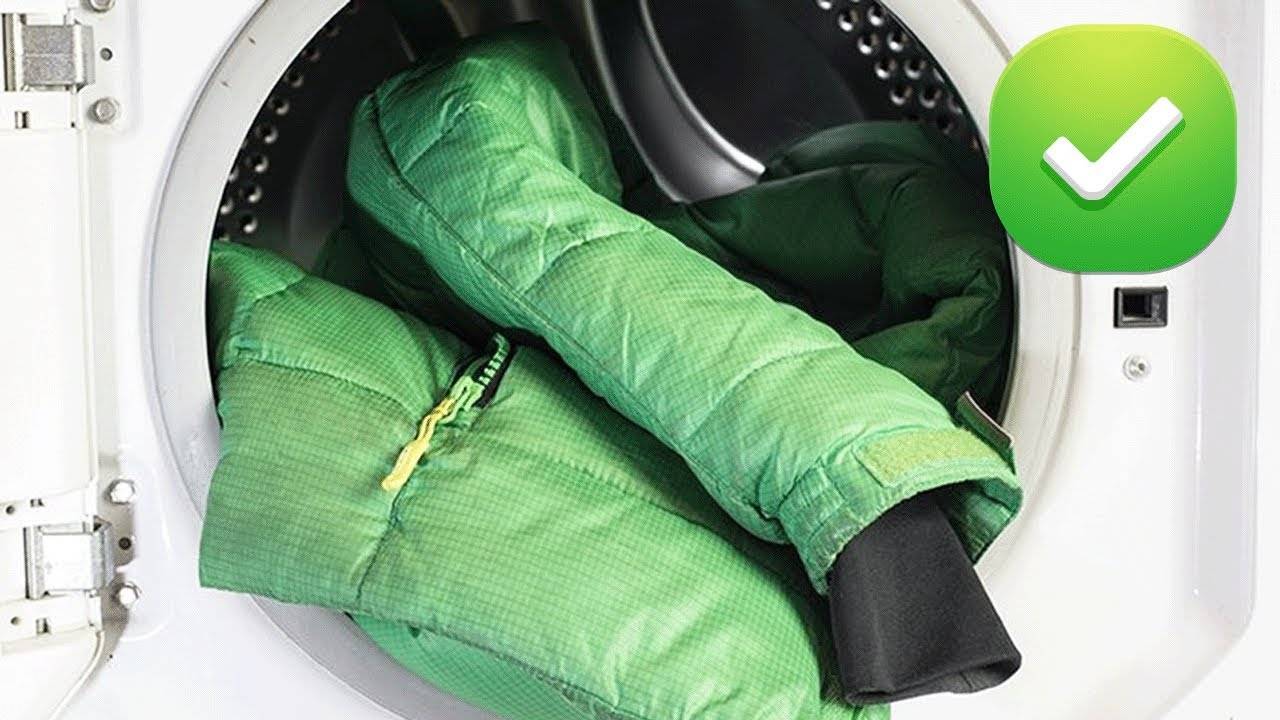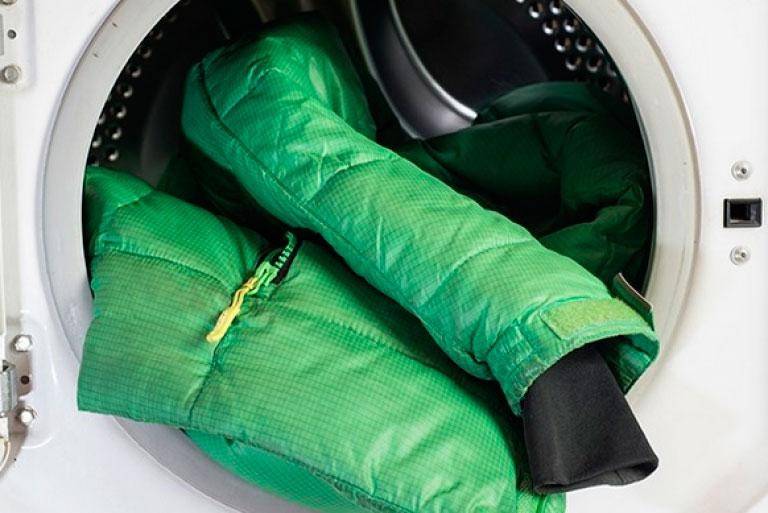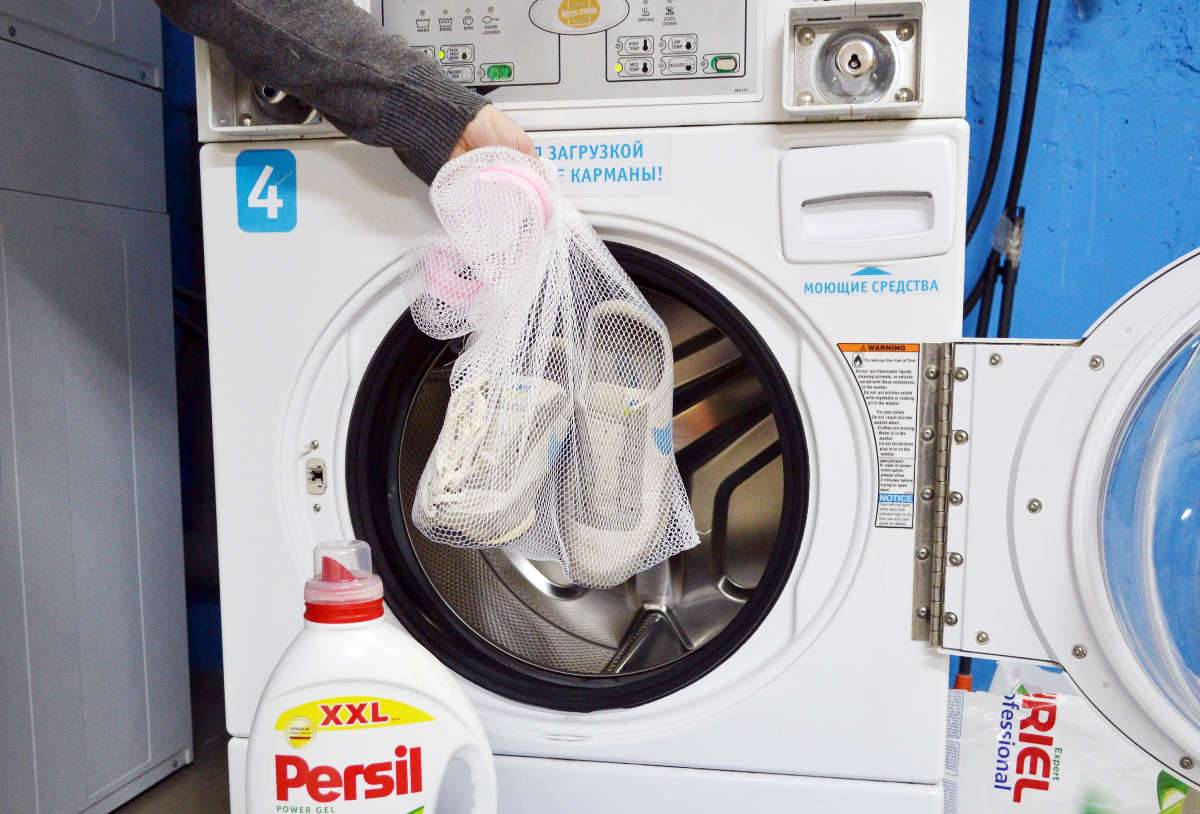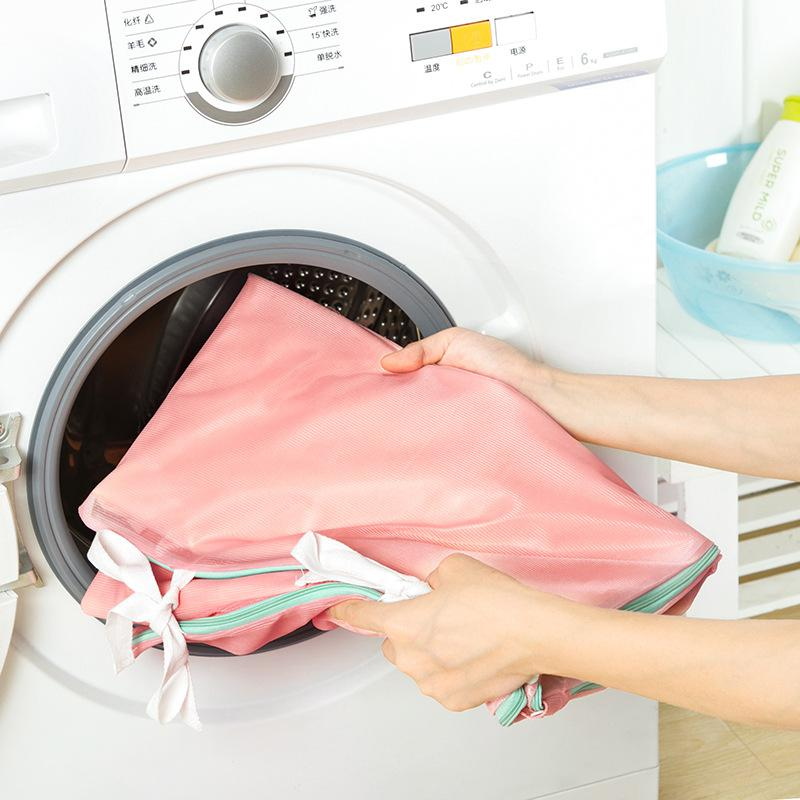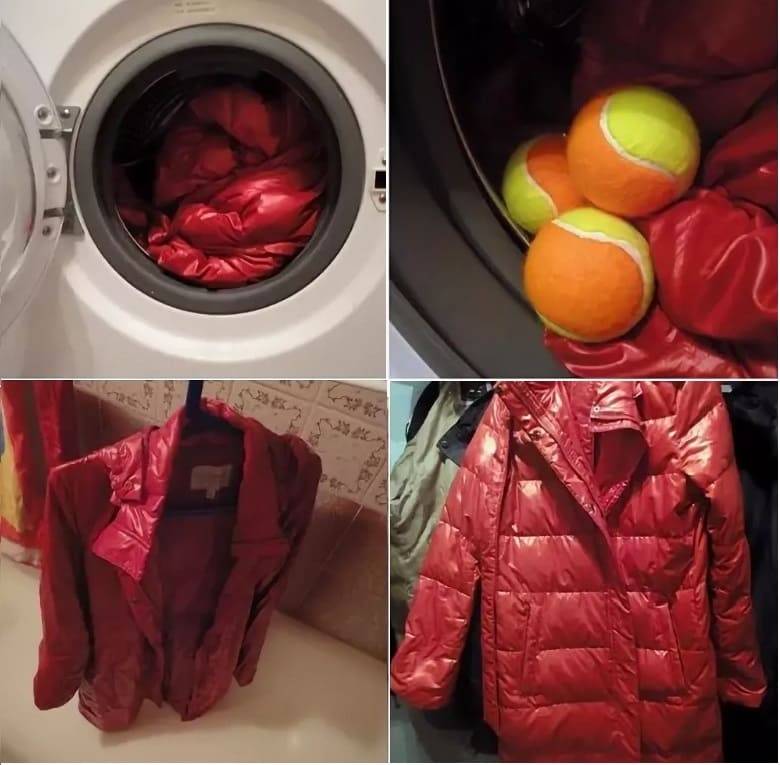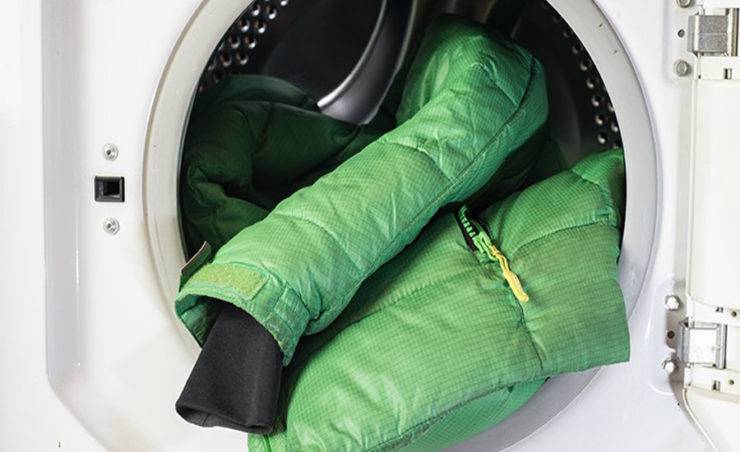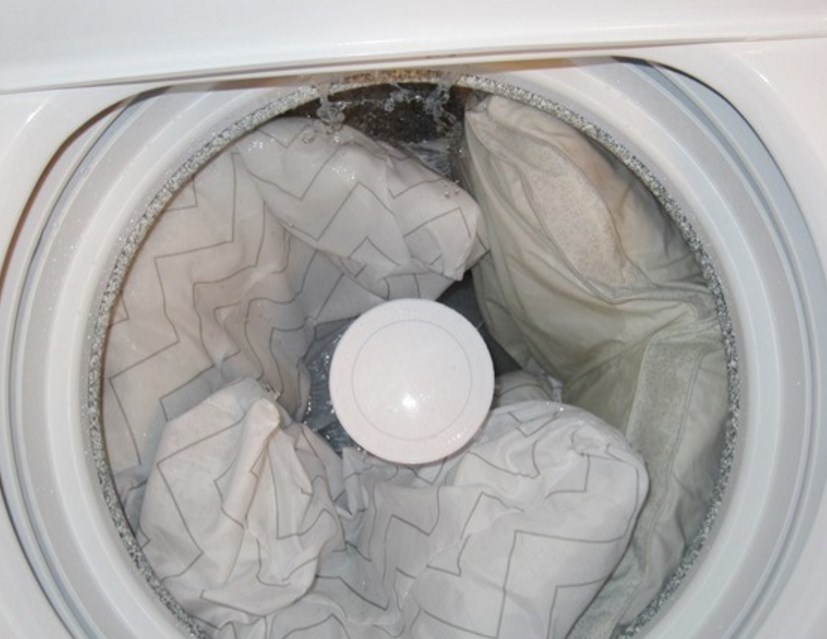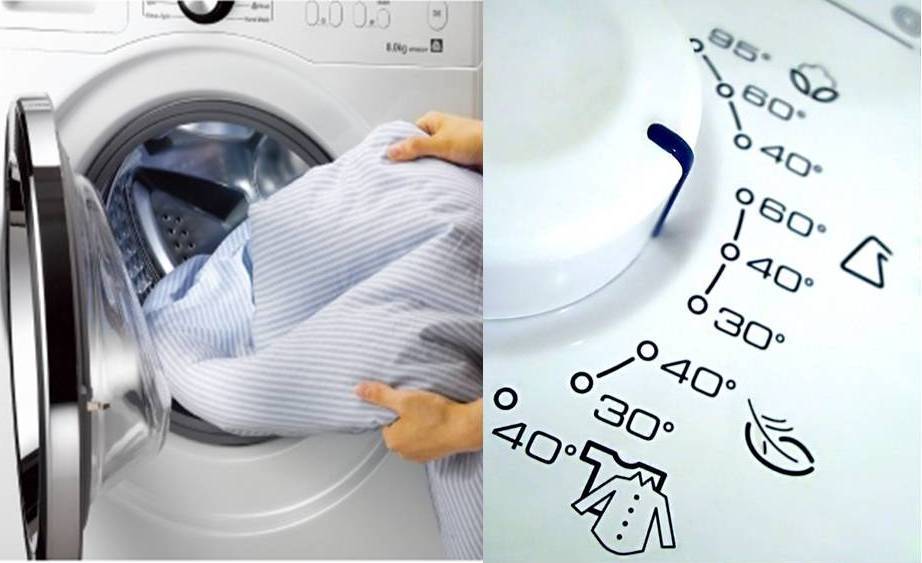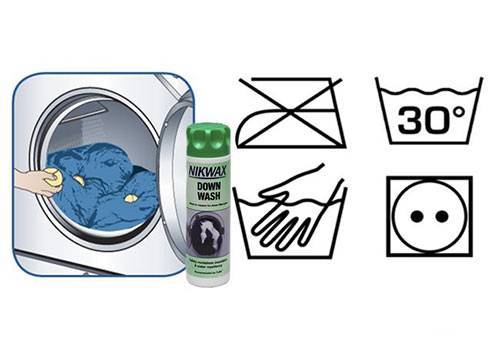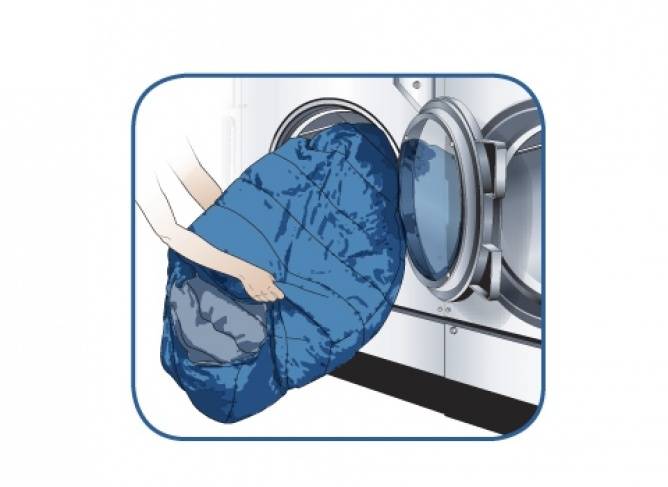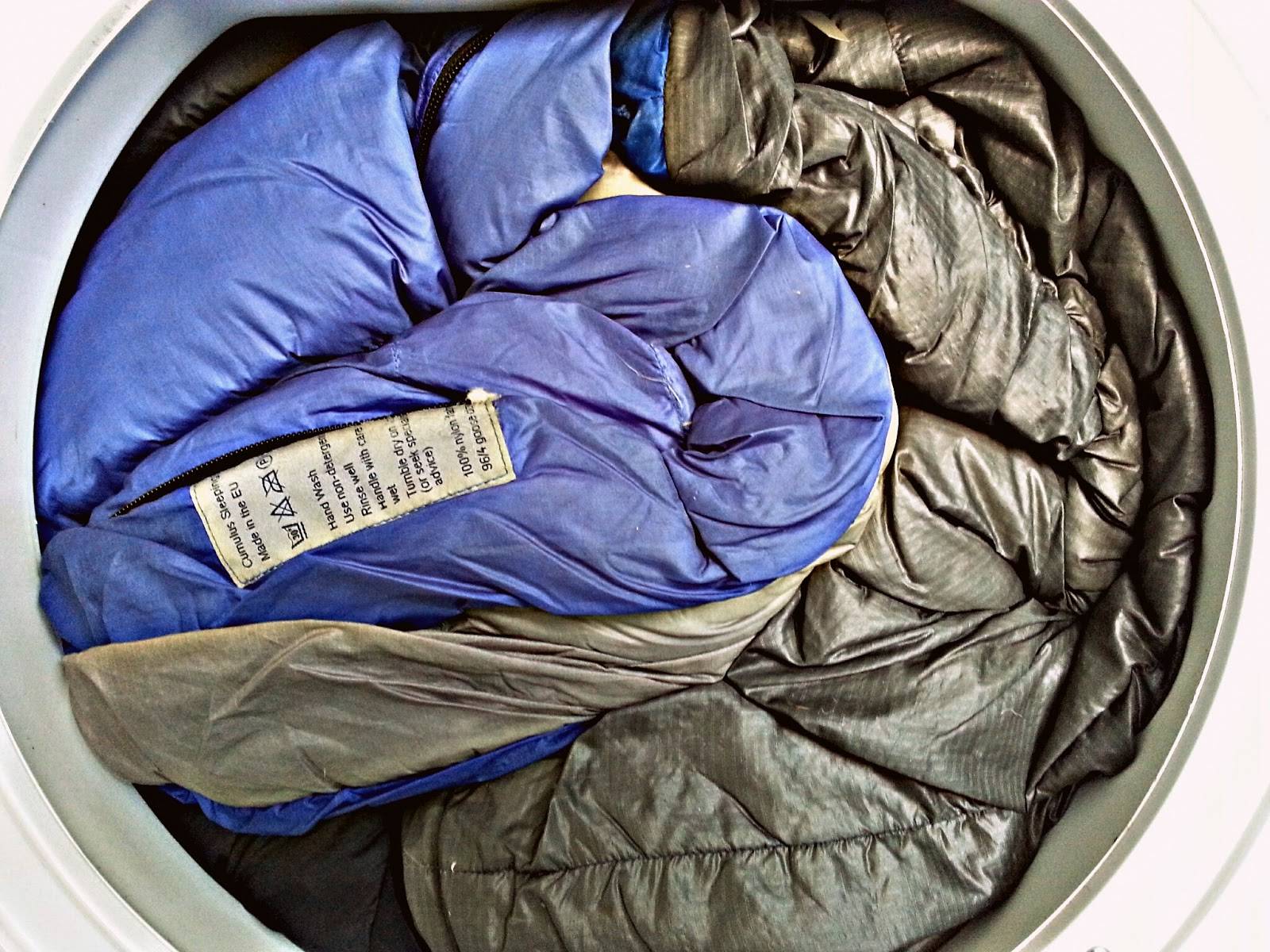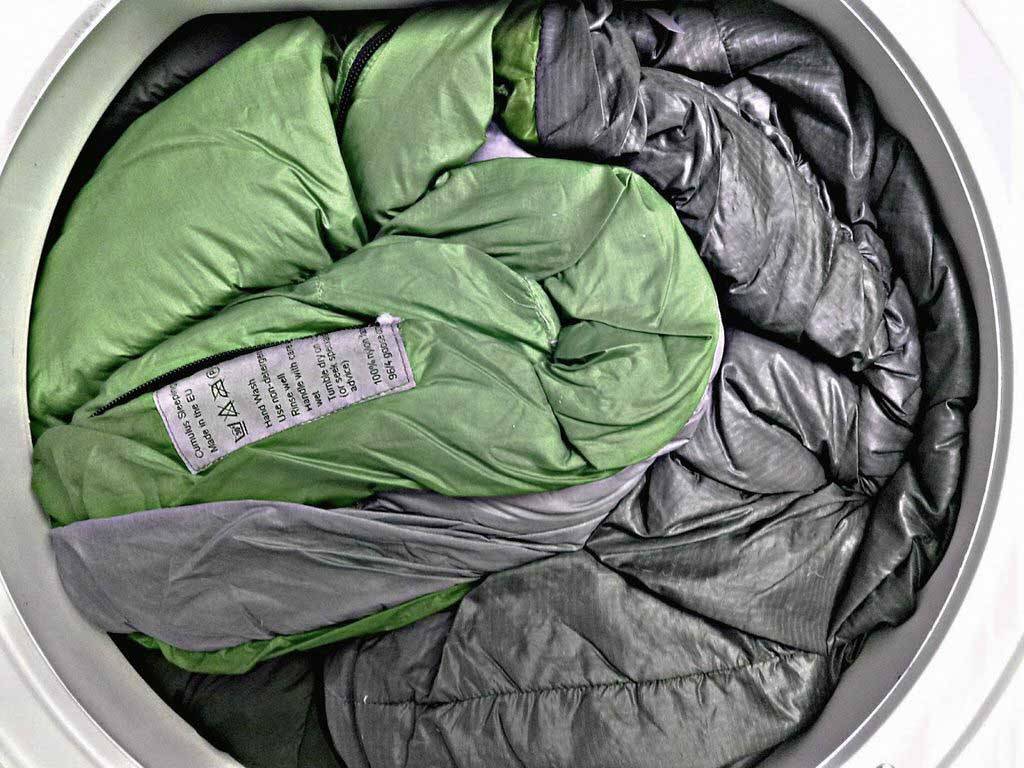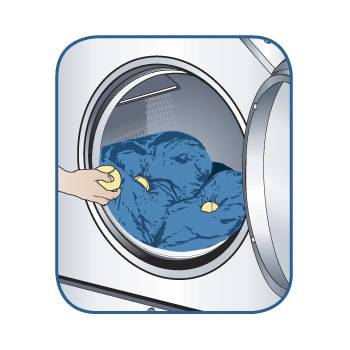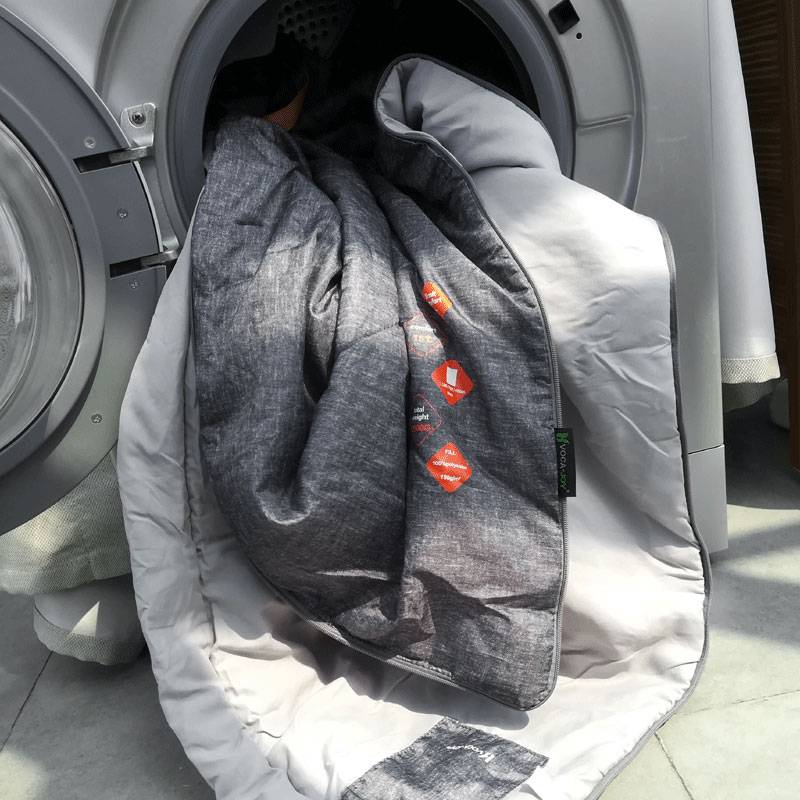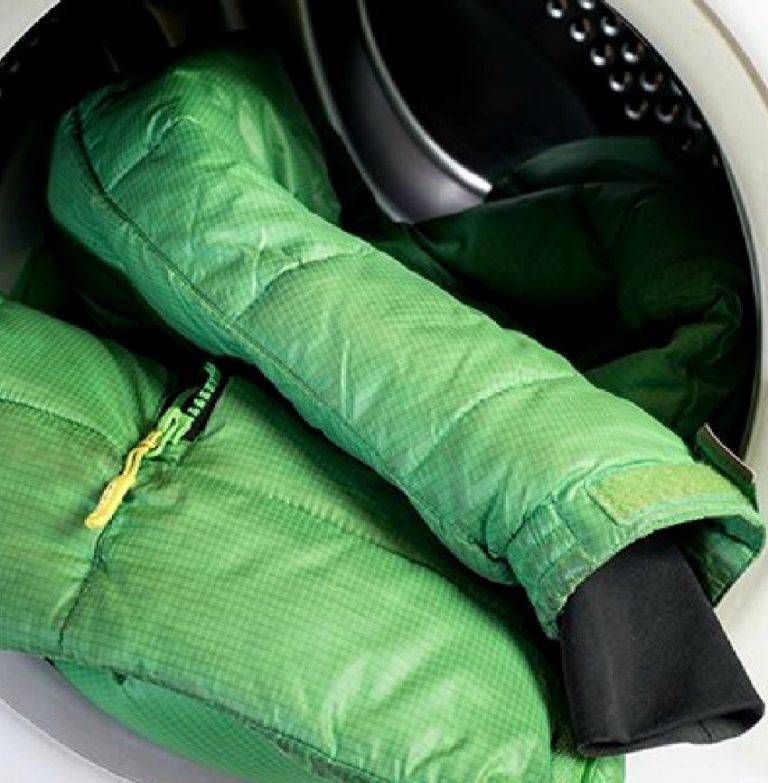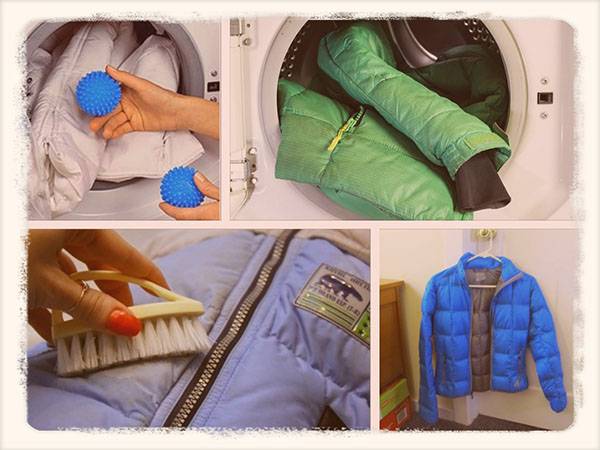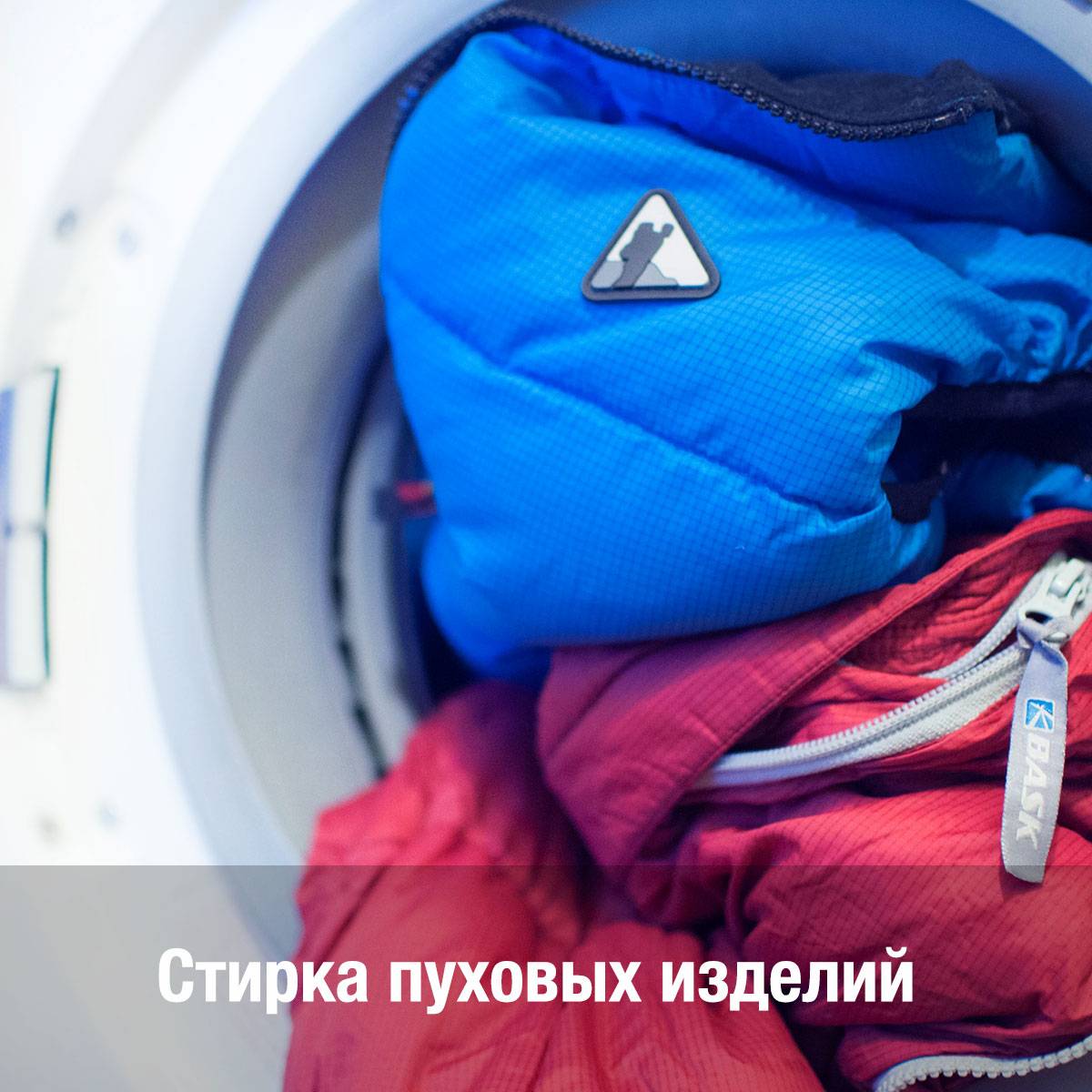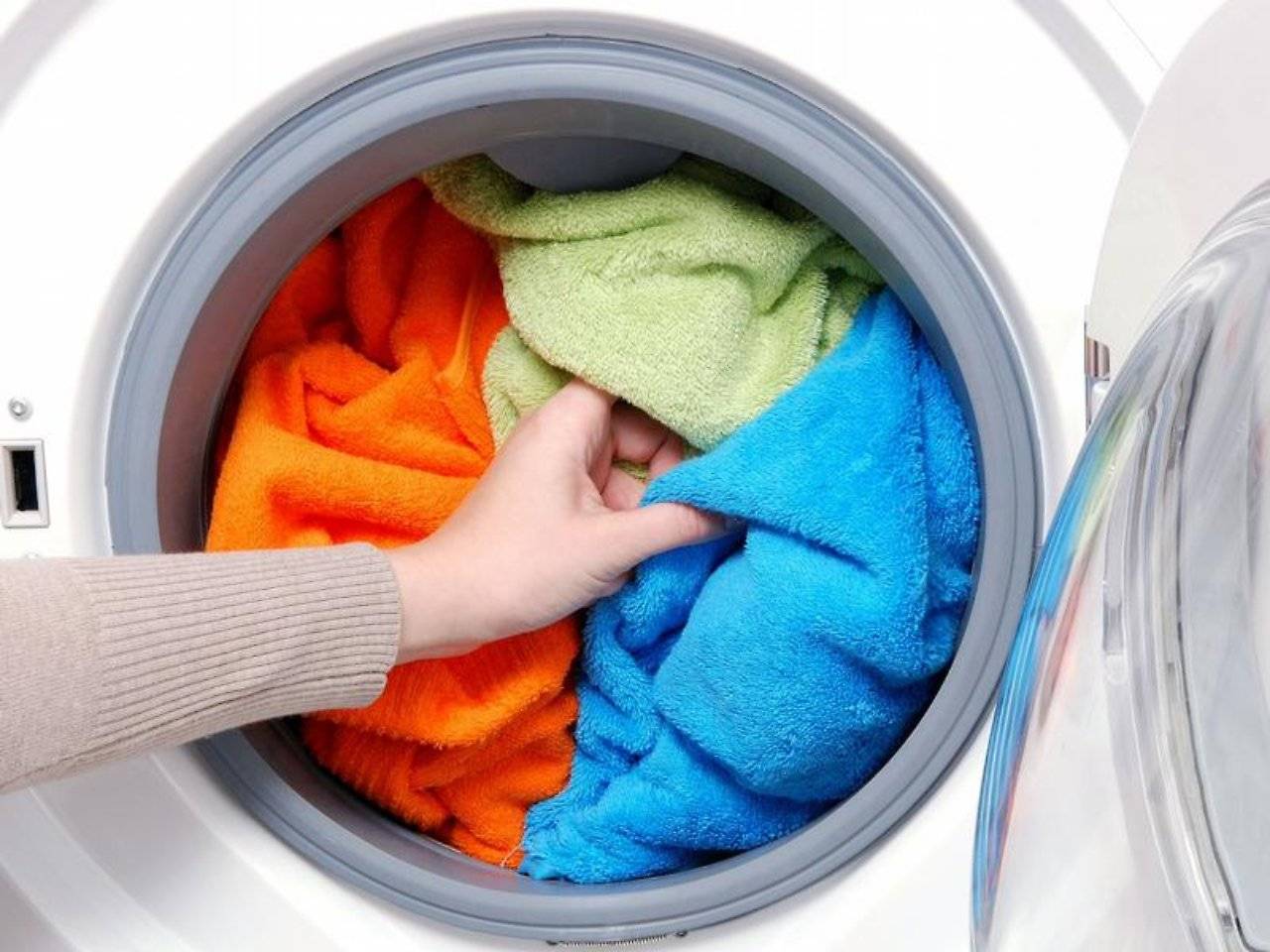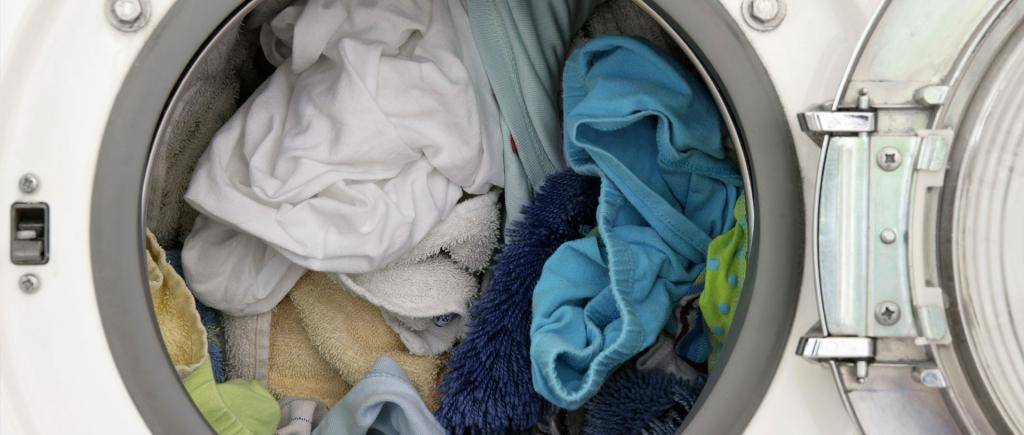How to wash correctly
Machine wash is a great help and saves the hostess when you need to wash something bulky and heavy. But keep in mind that a sleeping bag, or rather its filler, is damaged by high temperatures, aggressive wringing and improper detergents.
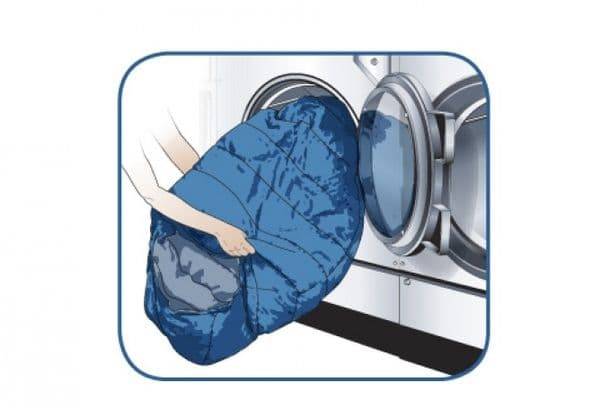
How to machine wash your sleeping bag correctly:
- Disable the spin function. This is the main cause of damage to the sleeping bag.
- Suitable modes are "Delicate" or "Hand wash".
- Water temperature - 30 degrees, maximum 40 (only with heavy pollution).
- Granular powders should not be used: they are poorly rinsed out of the filler. Choose gentle gels. Discard the whitening ingredients in the cleaner.
- Do not remove the garment from the drum immediately after washing: let the uncleaned water drain off a little. Or move the bag to the basin for 40 minutes. Be careful when removing, do not pull on the fabric, so as not to damage the filler.
Wash sleeping bags inside out! Thoroughly shake out all sand and other debris before immersion in the drum. Close all zippers, loosen your puffs. If the wash has not been done for a long time, and the fabric is covered with serious dirt, try to soak the bag for 10-20 minutes first, and then send it to the machine.
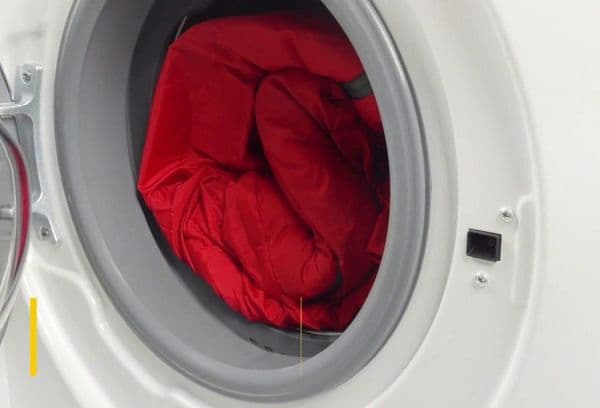
How to clean small stains without a total wash:
- Dilute a warm solution with baby or laundry soap in a basin, you can take shampoo.
- Dip a soft brush or sponge in the solution. If the stain is small, an old toothbrush will work.
- Rub the dirt, if necessary, let the detergent work for a few minutes.
- Rinse off the solution with clean water by wiping down the material with a rag.
Hand wash
Hand washing is not only a gentle care option, but sometimes the only way to wash it. For example, especially warm models of Alexika sleeping bags reach 5.5 kg of weight, and not every machine will accommodate them.
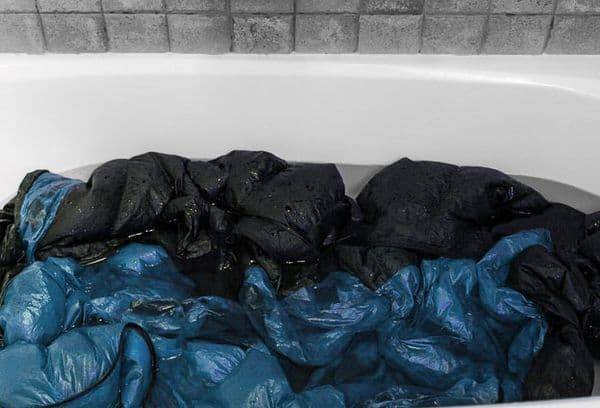
Before hand washing, the same manipulations are carried out: turn out the bag, shake out the debris, if necessary, treat difficult stains with laundry soap. It is better to wash a large sleeping bag right in the bathroom or in a huge basin.
A fun way to wash your sleeping bag in the tub:
- Fill the bathtub by a third with warm water, dilute the detergent.
- Place the sleeping bag at the bottom.
- Stand on it with your feet and walk for 10-15 minutes.
- Drain the soapy water and fill the tub with clean water.
- Rinse the product gently with your hands, change the water a couple more times.
- Do not squeeze or twist the sleeping bag, just squeeze it a little and leave it in the bathroom to let some of the water glass.
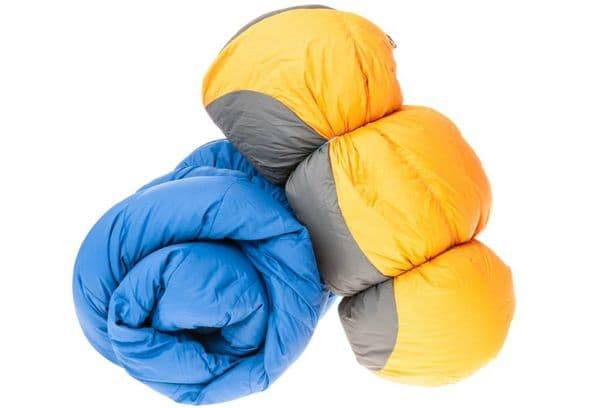
After washing, it remains to properly dry the equipment. The bag is laid out on a horizontal surface, preferably on an absorbent terry cloth. Alternatively, use a dryer with a bowl of water underneath it.
And a few more tips in the end: never leave a sleeping bag wet after a hike, dry it, do not expose it to ultraviolet radiation for a long time, use earbuds and sleep in clean clothes, keep the product away from a fire.
Sleeping bag washing can be done at home, but if you're worried about an expensive item, entrust it to a professional cleaning service.
What do manufacturers write about washing
The sleeping bags are labeled with proper care instructions to ensure long, trouble-free use.
Airing after each use
Airing helps to remove the smell and moisture absorbed in the cold night. After use, the sleeping bag is hung up to refresh in a dry place.
Washing only as a last resort
It is not necessary to wash the sleeping bag often, only in cases of heavy pollution. With not very intensive use - no more than once a year.

If possible, use only hand wash or top-loading washing machine. To keep the filler intact, it is better to use the hand wash or the delicate mode of the washing machine. Top-loading machines are not popular in our country, most of the tourists use conventional front-loading home machines.
Using a washing bag
Washing bags protect the sleeping bag from the aggressive effects of the drum, prevent tearing and damage.
A mild soap solution as a detergent
Chemicals destroy the protective layer on fabrics and fillings. It is recommended to wash your sleeping bag in a simple soapy solution.
Obligatory rinse at the end of washing
By rinsing out the detergents, you can restore the filler to its natural state. Splendor and softness will be restored. The machines use an additional rinse.
Against stains and streaks - a sponge with soapy water
Stains and water marks formed during operation can be removed from the sleeping bag with a sponge dipped in soapy water. You may be able to avoid washing this way.
Do not squeeze and twist a wet sleeping bag
If the sleeping bag is very wet, it should not be rolled up and wrung out. You need to squeeze slightly without twisting so that the water comes out, and spread out to dry.

Can only be dried in high volume dryers
Drying the sleeping bag is possible only without excessive squeezing and deformation. The dryer must have a large volume so that the bag does not have to be pushed into it.
Should dry only flat
A vertical dryer for sleeping bags is not used so that the filler does not sag under its own weight. A wet sleeping bag is laid out on a horizontal surface - a mesh or lattice is better.
Care and maintenance
Keep the bag dry when camping and at home. Otherwise, in the first case, you will have to sleep in a damp sleeping bag, and in the second, there is a high risk of mold. Among other things, harmful bacteria appear and actively multiply in a raw product. Do not drink or eat in a sleeping bag or nearby. Ventilate the product regularly for at least ten minutes.
Before applying the attribute, lay a sheet inside. It absorbs sweat and keeps the product clean and presentable for a longer time. Plus, washing a sheet is easier, faster and safer than a sleeping bag. Instead of a sheet, you can buy a special liner. It is more practical and more convenient, as due to reliable fixation it will not slip during sleep
When folding the bag into the cover, be careful not to create unnecessary or accidental folds and folds. Otherwise, the product will quickly rub off. Regular and competent maintenance will provide the inventory with a long service life and preserve the presentable appearance of the product for a long time.

We store it correctly
Proper storage is the key to the durability of your sleeping bag. Make sure it is dry well before folding it. Storing a wet bag is strictly prohibited.
There are 3 most preferred storage methods:
- Suspended. If space permits, you can throw the bag over the rope and straighten it as much as possible. This storage method will prevent the filler from crushing and deterioration.
- Under the bed. Not a bad storage option. To do this, unfold the bag and cover with a not too thick cloth to prevent dust from entering.
- In a pillowcase or special bag. The bag did not come with a capacious bag from the manufacturer? Take the money and buy one at any travel store. Another way: gently roll up the sleeping bag and pack it in a regular pillowcase. This option will suit those who do not have extra free space in the apartment. The main disadvantage of twisting is that the filler is crumpled and after straightening it returns to its original shape for a long time.
How to store a sleeping bag for a long time?
In order for a thing to serve for a long time, it is important to know not only how to wash a sleeping bag, but also how to store it correctly. The recommendations of manufacturers and seasoned tourists are as follows:
- Make sure your sleeping bag is dry first. Do not put it in a cover when wet.
- At home, it is advisable to keep the sleeping bag open. If space permits, you can hang it on a rope or rod inside the cabinet.
- A good way to do this is to keep it open under the bed. If there is no room at all, then use a special cover or cotton bag. In this case, you can store it together with other things.
Almost every hiker in the forest, in the mountains or to the river has a sleeping bag. After all, this is a fairly convenient thing that helps to sleep well in unusual circumstances and recuperate.
But, unfortunately, it has the same ability to get dirty as any bed linen. And then the question arises: "How to wash a sleeping bag?" The answer to it depends on many factors, which must be well understood before proceeding with the solution of the issue.
How to properly care for your sleeping bag? In order for it to be in perfect order and not fail prematurely, it is necessary to take into account some nuances. One of the most important is the composition of the filler, on which the type of washing largely depends.
Moisture protection will help keep your sleeping bag in top condition. Therefore, it is better to keep it away from water.
Ventilation is also important, therefore, during the hike, it is necessary to place it in the sun every day for at least a few minutes.
A special liner will protect the sleeping bag from dirt. Made of artificial silk, it will also play the role of an additional heat insulator. But besides, you will not need to wash the sleeping bag unnecessarily, and it will be enough to wash only the liner.
Storing a sleeping bag
Only a clean and well-dried bag can be sent to the closet for storage. On the shelf, the product should not be crushed by other things. It is better to give him a certain free space and provide air access. It is advisable to store the sleeping bag in its original breathable cover.
You can hang the bag on a closet bar or put it in a drawer under the bed. It is advisable to periodically take out and shake the filler so that condensation does not accumulate in it.
Special air fresheners will give a pleasant aroma to the sleeping bag. closet with clothes or cotton balls soaked in your favorite oil, such as lavender.
The fabric and filling of the sleeping bag are impregnated with a special protective compound. It should be understood that every wash, even hand wash, gradually destroys this layer. Therefore, it is necessary to treat expensive camping equipment with care in order to keep it clean as long as possible. Remember the manufacturer's recommendations on the product label. If you're worried about ruining your sleeping bag, you can go to the dry cleaner.
ÐÐ ±
Burgundy lily bush Ñ? Lightning
- B, b, b, b, b, b, b, b, b, b, b.
- Rose and Rose, Rose, Rose, Rose, Rose, Rose, Rose, Rose, Rose, Rose, Rose, Rose, Rose, Rose, Rose, Rose, Rose, Rose, Rose, Rose, Rose, Rose, Rose, Rose, Rose, Rose, Rose, Rose, Rose, Rose, Rose, Rose;
Rose, Rose, Rose, Rose, Rose, Rose, Rose. Got it?
- Bridging, bridging, bridging;
- Close up and down on a line on a line Return;
- Resolve, lokl, lokl, lokl, lokl, lokl.
Tint and tint! Burgundy, bush, bush In the morning
 Power supply, power supply, power supply? Bump, bump, bump, bump, bump, bump! Bush, bump, bump:
Power supply, power supply, power supply? Bump, bump, bump, bump, bump, bump! Bush, bump, bump:
- Burgundy ¸ и пÑÐ »Ð¸;
- Burgundy, burgundy, birch, bark Flare. Service;
- Burgers .
Victory! Saucer, tartar, tartar, tartar, tartar Good luck!
Manually
It is possible to wash a tent in a car either very rarely or not at all. What should the tourists who actively use the tent do, what should they do if the tent needs maintenance quite often? Experts advise to resort to dry cleaning or, in extreme cases, to hand wash.
If you want to save a thing, it is better to do without washing at all, but if this is not possible, we will do the following.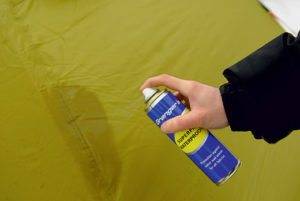
- We spread the tent on the grass.
- We water the tent with water, and then, without unnecessary mechanical stress, we rub it with a piece of laundry soap.
- Then you need to use someone's help, one person will water the tent with water, while you rub it with a sponge.
- Next, turn the tent over to the other side and do the same, rub it with soap and wash it off along with the dirt.
- Dry your tent and then spray it thoroughly with an anti-odor spray.
There are quite a lot of odor sprays on sale, you can take any, for example Toko Proff. It will rid the tent fabric of mold and laundry soap odors, but if you don't mind smelling like that, you can do without a spray. Also remember that washing the tent is half the trouble, you still need to check its protective layer after washing and if you need to restore it.
We do without washing
If you care about the safety of your tent, it is better not to wash it, but to clean it. Dry cleaning without unnecessary mechanical stress is the safest, but it does not remove dirt and odor as well as washing. What should be done?
After the hike, hang up a wet and dirty tent in a dry, ventilated place and let it dry well. The fabric of a good tent is covered with sunscreen and moisture-resistant impregnation, so you can dry it even in direct sunlight, but it's better if you find a shaded place for this.
So, the dry tent needs to be spread out and examined. Dry dirt and debris should be brushed off with a very soft brush or cloth. If stains remain in several places, you can treat them with a sponge dipped in soapy water. After such procedures, the tent is thoroughly dried again, and then put into the pantry before the next trip.
So, it is theoretically possible to wash a tent in a car, while it may not suffer from one wash. But you must remember that washing your tent is a big risk. Washing can ruin the protective layer of the fabric, after which the tent will become unusable.So it's up to you to wash or not wash, our advice should be washed only as a last resort, after dry cleaning has not yielded results. Good luck!
Sleeping bag washing
 The sleeping bag should not be washed after every ride. It is enough to dry and ventilate it, and arrange a "bath day" only in case of strong pollution.
The sleeping bag should not be washed after every ride. It is enough to dry and ventilate it, and arrange a "bath day" only in case of strong pollution.
Why does the sleeping bag lose volume after each wash? In downy bags, the ability of the filler to fluff up ("loft") is achieved by treating it with special substances based on silicone. When cleaning, they are washed out, the fluff rolls down and winds on the cores of the fluff, losing in volume. Washing synthetics even in warm water destroys its structure and "sticks" particles together. To minimize losses in the event that washing is inevitable, you need to carry out it according to the instructions for the product, order a professional treatment, or gently wash and dry at home, observing all the rules.
Washing your sleeping bag correctly in the machine
For washing down products, you cannot use ordinary powders - only special products.
Professionals recommend Nikwax Down Wash, ReviveX Down Cleaner (Synthetic Fabric Cleaner) or Granger's Down Cleaner, as well as Russian-made UniPuh. They do not wash out silicone additives, natural feather oils and the beneficial substances that sleeping bags are sometimes treated with (against ticks, mosquitoes, etc.). For subsequent treatment, you need to purchase a water-repellent impregnation, for example, Nikwax Down Proof spray.
If there are no special products at hand, you can use liquid detergents recommended for baby clothes.
 Washing process in the machine:
Washing process in the machine:
- make sure that the product is labeled “machine washable”;
- open the zipper and turn the sleeping bag outward, leave the slider in the middle of one of the sides;
- choose a front-loading machine (to make it easier to take out), designed for at least 6-7 kilograms;
- add a special agent to the powder pocket;
- choose a gentle mode without spinning, with an additional rinse, temperature of 30 degrees;
- to “massage” the fluff, you can put several tennis balls in the drum;
- After the sleeping bag has been washed in the washing machine, leave it for an hour to drain off excess water.
For machine washing of padding polyester and synthetic (for example, from holofiber) sleeping bags, it is recommended to take a liquid powder without conditioner and bleaching agents. The process itself is similar to downy products.
Hand wash - a more gentle but time-consuming process
Washing a sleeping bag by hand:
- fill the bath with warm water, dissolve special products;
- open the sleeping bag, turn it out, relax the strings;
- soak the product in water, shaking it periodically (in no case rub or squeeze hard);
- drain the water by removing the plug (do not touch the sleeping bag itself);
- pour clean water, rinse, drain;
- repeat step 5 several times (rinsing the product takes longer than the process of washing and soaking);
- leave the sleeping bag for an hour to drain the excess water.
Professional sleeping bag cleaning - manufacturer recommended
It is risky to give a sleeping bag to dry cleaning: they often practice old, Soviet methods of cleaning with the use of chemically active substances. It is worth giving preference to organizations specializing in working with downy products. How to wash sleeping bags in a professional salon:
- in a volumetric front-loading drum, the sleeping bag rotates along with small rubber bobbins;
- crawled feathers and down are pulled out with a special built-in vacuum cleaner;
- within 5 minutes, the product is treated with hot steam: this way the residues of fat, salt and dirt are removed;
- the washed sleeping bag is dried at a temperature of 120 degrees;
- at the end, the product is treated with ultraviolet light; as a result of ionization, the filler is saturated with keratin.
This procedure is recommended by the manufacturers of sleeping bags.
Handwash
For the entire period of using the tent, you can wash it in a typewriter with an automatic machine a maximum of 2 times. You will have to manually remove dirt in the future. Several options for hand washing are used:
On one's own. Fill the bath with water no higher than 30 degrees. Soak the tent for half an hour. Stand on her feet and trample. Rinse. Dry. The method is suitable for removing small dirt and dust.
Together. The tent is spread on a flat, clean surface (for example, washed concrete, asphalt, wood). One person pours water, the second lathers with laundry soap and wipes it with a soft sponge. Similarly, the procedure is repeated on the reverse side. The foam is washed off with copious water. The awning is dried, treated with a water repellent, spray to remove the smell of soap.
Nikwax Tech Wash anti-stain agent for hand washing membrane fabrics. For cleaning, the tent is soaked in warm water (30-40 degrees). Add 100-150 milliliters of detergent
Stir gently, protecting hands with rubber gloves. Rinse, changing the water 3 times.
Means for hand washing of tarpaulins made of synthetic fabrics NikwaxR Polar ProofR
Place a tent in warm water, add 100 milliliters. Mix. Repeat the procedure with an interval of 5 minutes 3 times. Rinse in cold water. Dry in partial shade, in a draft.

The use of special equipment allows you to do without additional waterproofing with a slight wear of the equipment.
How does it work
Sleeping bags help to survive cold nights in nature, create comfortable conditions for sleeping. Available in several types:
- Cocoon. Takes up a minimum of space, the shape corresponds to the outlines of the body (tapers down). Has a hood, fits the body well.
- Blanket type (rectangular). More comfortable for sleeping, you can roll over. Hood may be included. Takes up more space, heavier, harder to carry on hikes.
- Combined. Combination of a rectangular shape and a hood.
Sleeping bags are made of natural or synthetic fabric. Synthetics, by tradition, are more durable, lightweight and, accordingly, expensive. For insulation, two types of filler are used - down, synthetic materials.
For a sleeping bag, the following characteristics are most important:
- good thermal insulation;
- ease;
- the ability to shrink well, taking up a minimum of space, and quickly expand, becoming fluffy and soft.
Important elements of a sleeping bag:
- stitching holding the filler (necessarily blind);
- hood, place for a pillow;
- high-quality zipper with bite protection and cold air closing valve;
- inner pocket.
The upper fabric of the sleeping bag is impregnated with solutions that repel moisture, dirt, and protect against wind and condensation.
Important: in order to preserve the protective and warming properties of a sleeping bag, it should be washed only when absolutely necessary.
How to wash
Sleeping bags don't like washing. Even if you do everything right, wash them according to the instructions, the insulation in it will shrink. This leads to a loss of thermal insulation properties. And no one wants to freeze on a hike if the nights are cool. Synthetic sleeping bags do not suffer as much from washing in the washing machine as filled with down. With the latter, you need to be careful, trying to do everything right. How to wash it properly? We will tell you about this.
Preparation
- Remove stains. Before washing, inspect it from all sides. If spots appear on its surface, they are removed using a sponge and soap solution.
- Bad smell. Does your sleeping bag smell bad? Make a potassium permanganate solution and wipe the inner surface of the product with it.
- Turn it out. Turn the sleeping bag inside out. Its inner side becomes dirty more often. In addition, the outside of the material is often made waterproof.
- Choosing a washing powder.Do not use regular laundry detergent if it contains corrosive substances. Buy liquid detergents that are also used for washing your laundry. If your sleeping bag has down filler, go to the store for a special product that is recommended to wash the down. Use it in limited quantities so that there is not a lot of foam.

Wash your sleeping bag inside out
Washing
You can wash your sleeping bag by hand, but it is much more convenient to do it in a washing machine. Explore all the functions of your toy car. Choose a mode for your sleeping bag designed for washing down jackets. Don't you have one? Then set up a delicate wash, the temperature is not higher than 30 degrees. Make sure that the washing machine does not spin the product. After washing, the sleeping bag will need to be rinsed again, so turn on this function in the washing machine as well.
Drying
Take the product out of the machine. Water will drain from it. Gently transfer it to a basin and spread it on a flat surface above the bathtub so that the water can flow down. You cannot squeeze it out.
You can dry your sleeping bag in a dryer. But only after it dries a little, and at a low temperature. Overheating is dangerous for the sleeping bag material. You can put 2-3 tennis balls or clean socks rolled into a ball into the tumble dryer. They will help to distribute the fluff evenly.
There should be no heating devices nearby. The synthetic sleeping bag will dry itself without touching it. If there is fluff inside it, you can shake the sleeping bag from time to time. Then the fluff will be straightened and distributed throughout the product. It will dry for a long time, 1-5 days.
How not to wash your sleeping bag?
How not to wash your sleeping bag? There are a number of mistakes that people often make in an attempt to return cleanliness and freshness to a sleeping bag. Among the main mistakes are the following:
- Washable at 90 degrees.
- Washing in the main mode.
- Putting the sleeping bag in the drum of the machine in a crumpled form.
- Using a large amount of washing powder or liquid gel.
- Opt for dry cleaning services. You can use the services of dry cleaning only if it specifically offers washing of such products. In other cases, there is a high probability of damage to the product, since the material of the sleeping bag can behave unpredictably under the influence of various chemical detergents.
Recommendations for correct washing will help prevent mistakes and guarantee the correctness of the process. Remember that in many cases you can do it without washing at all.
For example, small dirt on the outside of the product can be easily removed with a sponge or brush, which is pre-moistened with soapy water.
If the dirt is still serious enough, you can try hand-washing the product.
This is done in accordance with the following algorithm:
- pour warm water (not hot) into a basin, bath or other container;
- top up with mild detergent;
- immerse your sleeping bag in the water;
- using a sponge, get rid of all dirt.
Very often, such a simple procedure is enough to make the product clean again. It remains only to dry it. How? You will learn about this below.
If the pollution is so serious that it is not possible to cope with it manually (or maybe there is simply no desire for it), you can use a washing machine.
It is recommended to follow these tips:
- set the temperature to 30 degrees;
- use the "washing down jackets" mode, if there is one;
- you can wash the product in the "hand wash" mode;
- an alternative mode for washing - delicate;
- use only mild detergents;
- finally enable additional rinse (if this function is not available, it is recommended to rinse the product by hand).
If you wash the product in a washing machine, adhering to these recommendations, it will remain intact.
